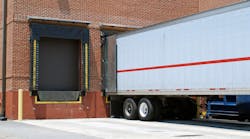In 2020, we saw an unprecedented string of supply chain disruptions, high pressure demands on essential products and services, and a mounting list of safety concerns—not the least of which was the threat of COVID-19.
As our essential businesses worked tirelessly to keep America running, many experienced safety concerns related to their central activity hubs—their loading docks. Most business leaders fail to understand and appreciate the risks for workers and equipment at the loading docks, and even fewer grasp the potential consequences.
According to OSHA, one out of four workplace accidents occur at the loading dock area, and there are 600 near-misses for every incident that ends up occurring. Equipment failures alone contribute to thousands of accidents around loading docks, including more than 110,000 incidents annually, costing businesses an estimated $135 million—and that’s only the incidents involving forklifts. It’s a serious safety issue, and one that too few businesses have sufficiently addressed. But what are the most common issues to watch for? And what can you do to guard against them?
1. Door Drift
It’s common for loading dock door springs, which are usually 20 to 30 feet high in the air, to be poorly or ineffectively adjusted or not adjusted at all. This can cause the door to “drift” down into the actual opening of the dock. Forklift drivers, not knowing the door has drifted, slam into the bottom panel of the door and the intermediate panels, causing damage. This damage then has further consequences, when the products or materials can’t be unloaded, new trailers can’t be loaded up and customer deadlines are missed, causing companies to have to pay detention fines. If the company doesn’t have replacement panels on site, this kind of repair could take days or even a full week to fix.
Door drift may leave a team unable to perform efficiently, scrambling to fulfill orders with fewer loading positions available.
2. Dock Leveler Lip Extension
A dock leveler lip, which is supposed to extend into the back of the leveler, doesn’t always extend out the way it should. This is commonly caused by spring and cable issues that usually occur because of lack of proper maintenance. When the lip does not extend out appropriately, employees often use their hands to hold the lip out, while someone either walks it down or uses a forklift to drive it down. This is an extremely unsafe practice and workers have been seriously injured this way.
3. Knocked-down Dock Bumpers
Dock bumpers can be popped off the wall, causing concrete damage, wall damage and product damage, when trucks grind up and down during loading and unloading of trailers. This is likely occurring more frequently now due to the use of air ride suspension trailers. The air in the truck bladders can now drop six to eight inches, which allows the up and down grinding motion. Additionally, yard jockeys have a tendency to move the trailers even more, getting under the dock bumpers and popping them off the wall.
To help prevent and avoid these common loading dock safety hazards, it’s important to conduct regular proactive maintenance on your loading dock.
Start by conducting a thorough safety assessment to survey the current condition of the facility and the equipment, and compile written and electronic evidence, then create a specific, tailored proactive maintenance program based on the data captured. Better yet, leverage a digital Internet of Things (IoT) tool to log maintenance and service data to track repairs over time.
This kind of program, which can be done most effectively with the help of technologically smart solutions, will help to ensure safe standards are met, productivity is maintained and performance is heightened.
Dennis Sanacore is vice president of strategic sales at Miner, the docks and doors special division of OnPoint Group. He has more than two decades of experience within the facility services, warehousing and logistics sector.




